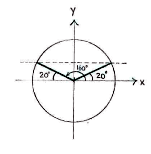Lösung 4.3:9
Aus Online Mathematik Brückenkurs 1
(Unterschied zwischen Versionen)
K (hat „Solution 4.3:9“ nach „Lösung 4.3:9“ verschoben: Robot: moved page) |
|||
| Zeile 1: | Zeile 1: | ||
| - | + | Wir verwenden die Doppelwinkelfunktion für <math>\sin 160^{\circ}</math> | |
{{Abgesetzte Formel||<math>\sin 160^{\circ} = 2\cos 80^{\circ}\sin 80^{\circ}\,\textrm{.}</math>}} | {{Abgesetzte Formel||<math>\sin 160^{\circ} = 2\cos 80^{\circ}\sin 80^{\circ}\,\textrm{.}</math>}} | ||
| - | + | Wir verwenden jetzt die Doppelwinkelfunktion für den Faktor <math>\sin 80^{\circ}</math>, nachdem wir den Faktor math>\cos 80^{\circ}</math> behalten möchten | |
{{Abgesetzte Formel||<math>2\cos 80^{\circ}\sin 80^{\circ} = 2\cos 80^{\circ}\cdot 2\cos 40^{\circ}\sin 40^{\circ}\,,</math>}} | {{Abgesetzte Formel||<math>2\cos 80^{\circ}\sin 80^{\circ} = 2\cos 80^{\circ}\cdot 2\cos 40^{\circ}\sin 40^{\circ}\,,</math>}} | ||
| - | + | Wir verwenden noch einmal die Doppelwinkelfunktion, dieses Mal für den Faktor <math>\sin 40^{\circ}</math> | |
{{Abgesetzte Formel||<math>2\cos 80^{\circ}\cdot 2\cos 40^{\circ}\cdot\sin 40^{\circ} = 2\cos 80^{\circ}\cdot 2\cos 40^{\circ}\cdot 2\cos 20^{\circ}\sin 20^{\circ}\,\textrm{·}</math>}} | {{Abgesetzte Formel||<math>2\cos 80^{\circ}\cdot 2\cos 40^{\circ}\cdot\sin 40^{\circ} = 2\cos 80^{\circ}\cdot 2\cos 40^{\circ}\cdot 2\cos 20^{\circ}\sin 20^{\circ}\,\textrm{·}</math>}} | ||
| - | + | Also haben wir gezeigt dass | |
{{Abgesetzte Formel||<math>\sin 160^{\circ} = 8\cos 80^{\circ}\cdot \cos 40^{\circ}\cdot \cos 20^{\circ}\cdot\sin 20^{\circ}</math>}} | {{Abgesetzte Formel||<math>\sin 160^{\circ} = 8\cos 80^{\circ}\cdot \cos 40^{\circ}\cdot \cos 20^{\circ}\cdot\sin 20^{\circ}</math>}} | ||
| - | + | oder anders geschrieben, | |
{{Abgesetzte Formel||<math>\cos 80^{\circ}\cdot\cos 40^{\circ}\cdot \cos 20^{\circ} = \frac{\sin 160^{\circ}}{8\sin 20^{\circ}}\,\textrm{.}</math>}} | {{Abgesetzte Formel||<math>\cos 80^{\circ}\cdot\cos 40^{\circ}\cdot \cos 20^{\circ} = \frac{\sin 160^{\circ}}{8\sin 20^{\circ}}\,\textrm{.}</math>}} | ||
[[Image:4_3_9.gif||right]] | [[Image:4_3_9.gif||right]] | ||
| - | + | ||
| - | + | Zeichnen wir den Winkel <math>160^{\circ}</math> im Einheitskreis, sehen wir dass der Winkel denselben ''y''-Koordinaten wie der Winkel <math>20^{\circ}</math> hat, und daher denselben Sinus. Also erhalten wir | |
| - | <math>20^{\circ}</math> | + | |
<center><math>\sin 20^{\circ} = \sin 160^{\circ}\,\textrm{.}</math></center> | <center><math>\sin 20^{\circ} = \sin 160^{\circ}\,\textrm{.}</math></center> | ||
| - | + | und also haben wir die Gleichung | |
<center><math>\cos 80^{\circ} \cos 40^{\circ} \cos 20^{\circ} = \frac{\sin 160^{\circ}}{8\sin 20^{\circ}} = \frac{1}{8}\,\textrm{.}</math></center> | <center><math>\cos 80^{\circ} \cos 40^{\circ} \cos 20^{\circ} = \frac{\sin 160^{\circ}}{8\sin 20^{\circ}} = \frac{1}{8}\,\textrm{.}</math></center> | ||
| + | |||
| + | gezeigt. | ||
Version vom 13:29, 5. Apr. 2009
Wir verwenden die Doppelwinkelfunktion für \displaystyle \sin 160^{\circ}
| \displaystyle \sin 160^{\circ} = 2\cos 80^{\circ}\sin 80^{\circ}\,\textrm{.} |
Wir verwenden jetzt die Doppelwinkelfunktion für den Faktor \displaystyle \sin 80^{\circ}, nachdem wir den Faktor math>\cos 80^{\circ}</math> behalten möchten
| \displaystyle 2\cos 80^{\circ}\sin 80^{\circ} = 2\cos 80^{\circ}\cdot 2\cos 40^{\circ}\sin 40^{\circ}\,, |
Wir verwenden noch einmal die Doppelwinkelfunktion, dieses Mal für den Faktor \displaystyle \sin 40^{\circ}
| \displaystyle 2\cos 80^{\circ}\cdot 2\cos 40^{\circ}\cdot\sin 40^{\circ} = 2\cos 80^{\circ}\cdot 2\cos 40^{\circ}\cdot 2\cos 20^{\circ}\sin 20^{\circ}\,\textrm{·} |
Also haben wir gezeigt dass
| \displaystyle \sin 160^{\circ} = 8\cos 80^{\circ}\cdot \cos 40^{\circ}\cdot \cos 20^{\circ}\cdot\sin 20^{\circ} |
oder anders geschrieben,
| \displaystyle \cos 80^{\circ}\cdot\cos 40^{\circ}\cdot \cos 20^{\circ} = \frac{\sin 160^{\circ}}{8\sin 20^{\circ}}\,\textrm{.} |
Zeichnen wir den Winkel \displaystyle 160^{\circ} im Einheitskreis, sehen wir dass der Winkel denselben y-Koordinaten wie der Winkel \displaystyle 20^{\circ} hat, und daher denselben Sinus. Also erhalten wir
und also haben wir die Gleichung
gezeigt.

